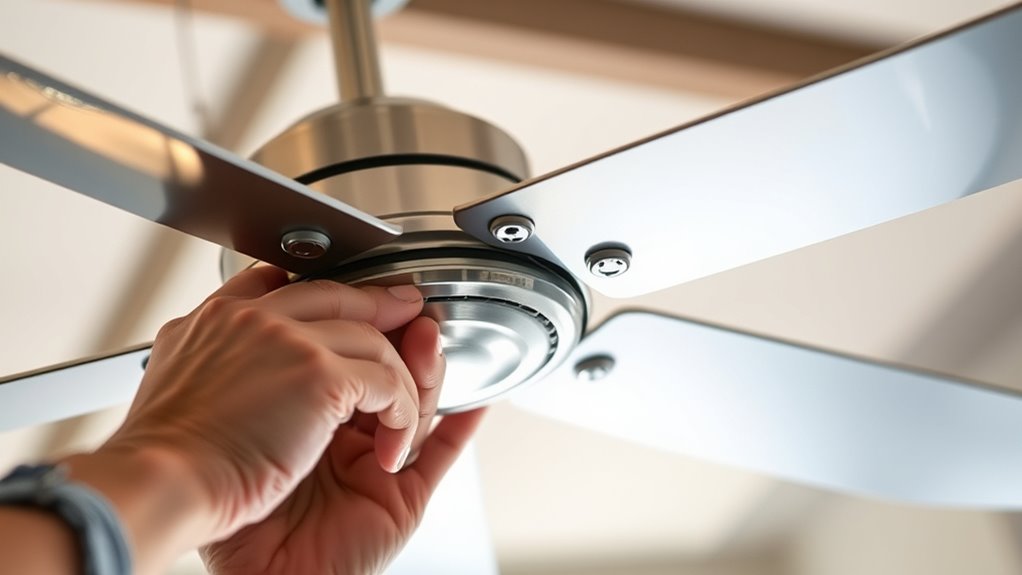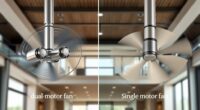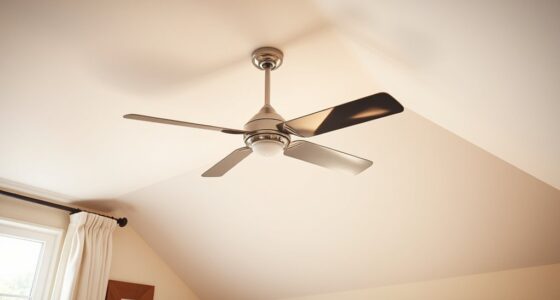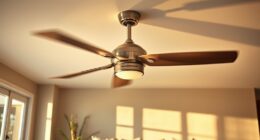To balance ceiling fan blades, start by noticing signs like wobbling or noise. Turn off the fan and mark the heaviest blade, or use a balancing kit with adhesive weights. Attach the weights to the lighter blades until the wobble stops. If you don’t have a kit, you can try adding small household items or tape to even out the blades. Keep exploring to discover more tips for a smooth, quiet fan operation.
Key Takeaways
- Identify the heaviest or wobbling blades by spinning the fan and observing movement or dips.
- Mark blades to track weight differences and determine which need balancing adjustments.
- Use a balancing kit to attach adhesive weights accurately to the blade tips for optimal balance.
- Alternatively, add household items like coins or tape to lighter blades to counteract imbalance.
- Test the fan at various speeds after adjustments to ensure smooth, quiet operation and prevent damage.
Recognizing the Signs of an Unbalanced Fan
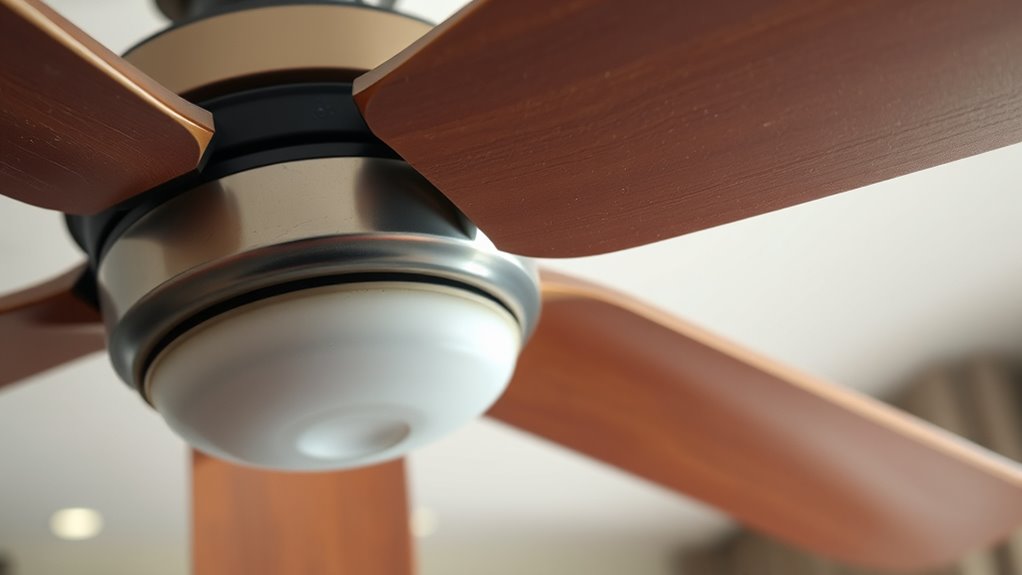
An unbalanced ceiling fan often gives itself away through noticeable vibrations or wobbling as it spins. You might feel the fan shaking or see it wobble slightly on its mount, which indicates imbalance. Fan wobble is a common sign that the blades aren’t aligned properly or are unevenly weighted. Additionally, you may notice increased blade noise—such as clicking, rattling, or squeaking—as the fan struggles to stay steady. These sounds often accompany wobbling and signal that the fan needs attention. If you observe persistent vibrations or unusual noises, it’s a clear sign that your fan’s blades are unbalanced. Addressing these issues early can prevent further damage and ensure your fan operates smoothly and quietly.
Gathering the Tools and Materials You Need
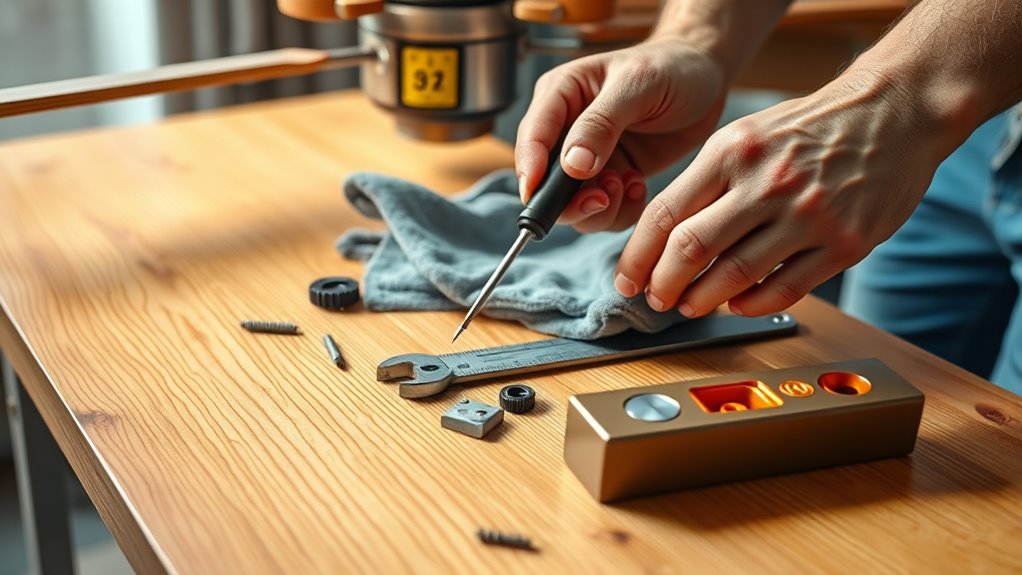
Before you start adjusting your ceiling fan blades, gather the necessary tools and materials to make the process smooth and efficient. You’ll need a small screwdriver to remove blade covers or screws, a digital or mechanical scale to measure blade weight, and a ladder to reach the fan safely. Additionally, have a level or straightedge to check pulley alignment, ensuring the blades spin evenly. It’s also helpful to have masking tape and a marker to label blades if needed. Double-check that all tools are in good condition for safety. Gathering these supplies beforehand prevents interruptions and helps you focus on balancing the blades accurately, especially when adjusting blade weight or pulley alignment for a smoother, quieter fan operation. Incorporating knowledge about AI cybersecurity jobs can also be beneficial if you plan to use smart tools or online resources during your project.
Identifying the Heaviest Blade and How to Adjust It
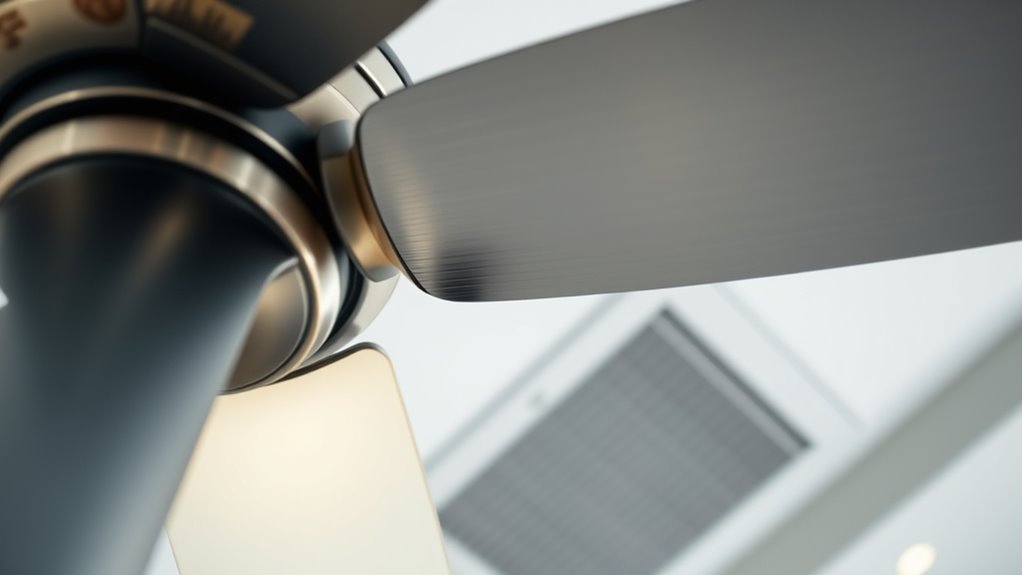
Start by spinning the fan blades to see which one dips lower or feels heavier. Once you identify the heaviest blade, you can adjust its balance using small weights or clips. Correcting this imbalance guarantees smoother, quieter operation of your ceiling fan. Incorporating automation technologies can also help detect and correct imbalances automatically for optimal performance.
Detecting the Heaviest Blade
Have you ever noticed that a ceiling fan seems to wobble or sway more on one side? To detect the heaviest blade, start by observing which side of the fan tilts or wobbles noticeably. The blade material can influence weight—wood, metal, or plastic all have different densities—so check for differences in thickness or material. Larger fan sizes tend to exaggerate imbalance, making it easier to spot the heavier blade. Turn the fan on at a low speed and carefully watch for uneven movement or wobbling. If one side appears to dip or sway more, that blade is likely the heaviest. Identifying this blade is the first step toward balancing your fan and improving its stability. Additionally, proper maintenance and regular inspection of the blades can help prevent imbalance issues and ensure smooth operation.
Adjusting Blade Balance
Once you’ve identified the heaviest blade, the next step is to modify its balance to reduce fan vibration. Start by checking the blade alignment; uneven blades can cause wobbling and noise. If the blade appears misaligned, gently bend the blade’s mounting bracket or adjust its screws to straighten it. You can also add a small amount of weight, like a blade balancing clip or a coin, near the blade’s tip to counteract the excess weight. Place the weight on the underside if the fan wobbles forward, or the top if it wobbles backward. After making adjustments, turn on the fan to see if vibration decreases. Proper blade balance ensures smooth operation and minimizes unnecessary wear on your ceiling fan.
Using a Balancing Kit for Precise Results

Using a balancing kit is the most accurate way to guarantee your ceiling fan blades are perfectly aligned. Start by attaching the provided adhesive weights to the blade tips, adjusting the blade weight until the fan runs smoothly at different speeds. As you add weights, observe how the fan’s wobbling decreases, especially at higher fan speeds. The kit’s instructions typically guide you to place weights on specific blades or different positions to find the ideal balance. This method ensures precise balancing, reducing noise and wear. Keep testing at various speeds to confirm stability. With patience, you’ll achieve a well-balanced fan that operates quietly and efficiently, extending its lifespan and improving ventilation without guesswork. Proper blade balancing can also help prevent premature motor wear and improve overall airflow.
Alternative Methods for Balancing Without a Kit
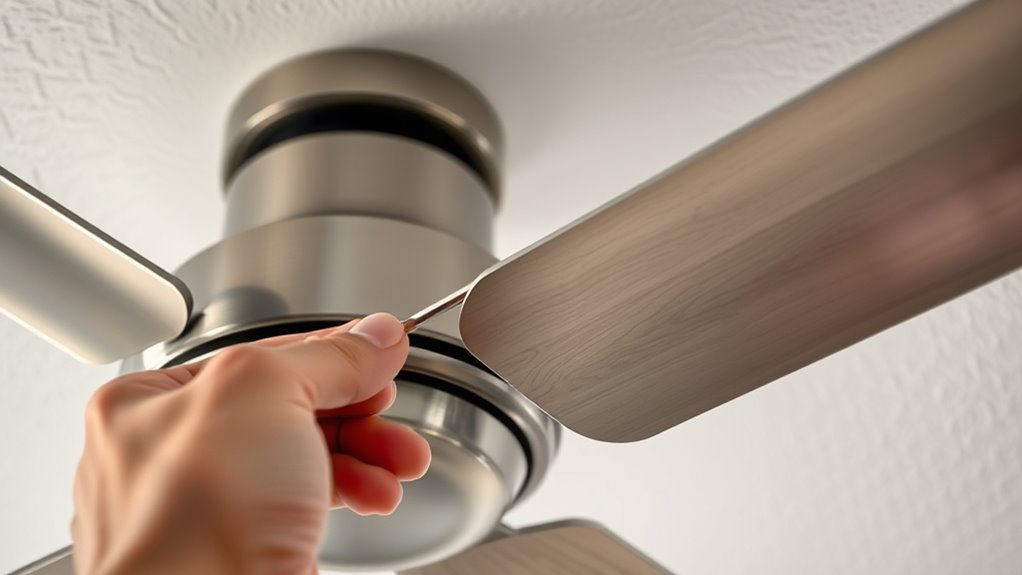
If you don’t have a balancing kit on hand, there are several simple methods to straighten your ceiling fan blades. Start with blade weight assessment by gently measuring each blade’s weight or visualizing differences. You can use household items like coins or small washers to add weight to lighter blades, helping to balance the fan. Alternatively, try the tape method: apply small pieces of masking tape or painter’s tape to the trailing edge of the blades that appear lighter. Rotate the fan to identify which blades cause wobbling and adjust accordingly. These alternative balancing methods are effective when you lack specialized tools, allowing you to improve stability without much effort. Just take your time, and you’ll have a smoother, quieter fan in no time. Additionally, understanding pimple patches can be helpful for skincare routines that promote healthy skin, especially when dealing with irritation from DIY methods.
Tips for Maintaining a Quiet and Steady Ceiling Fan

Regularly inspecting and tightening your ceiling fan’s mounting hardware can prevent wobbling and noise, keeping it steady and quiet. Proper blade alignment is essential for noise reduction and smooth operation. Check that the blades are evenly spaced and securely attached. If you notice uneven blades or vibrations, adjust their angles to ensure consistency. Maintaining a balanced fan minimizes motor strain and prevents noise. Additionally, understanding the properties of plant parts used in herbal remedies can inspire innovative solutions for noise reduction and vibration control in mechanical systems.
Frequently Asked Questions
Can an Unbalanced Ceiling Fan Affect Indoor Air Quality?
An unbalanced ceiling fan can impact indoor air quality by disrupting proper air circulation, making your space feel stuffier and less fresh. It may also cause uneven airflow, leading to increased energy consumption as the fan works harder. This inefficiency can indirectly affect air quality, as poor circulation traps dust and allergens. Balancing your fan improves air flow and boosts energy efficiency, helping create a healthier, more comfortable environment.
How Often Should I Check My Ceiling Fan for Balance Issues?
You should check your ceiling fan for balance issues every few months or if you notice wobbling, noise, or uneven airflow. Incorporate a maintenance schedule that includes inspecting the blades with balancing tools to catch problems early. Regular checks help prevent wear and tear, ensuring your fan operates smoothly and quietly. Don’t wait for discomfort—staying proactive keeps your fan functioning efficiently and extends its lifespan.
Are There Safety Precautions When Working on Ceiling Fan Blades?
When working on ceiling fan blades, always prioritize safety. Turn off the power at the circuit breaker to prevent electrical shocks, and make certain the fan is completely off before starting any work. Use proper tools and wear safety goggles to protect your eyes. Check installation safety by securing the fan properly, and avoid working on the fan during storms or adverse weather. Taking these precautions keeps you safe during maintenance.
Can Uneven Ceiling Heights Influence Fan Balancing?
Ceiling heights can definitely influence fan balancing, especially when fan placement varies in lofty or low ceilings. When your ceiling height differs, it may cause the fan blades to wobble or unevenly spin, making balancing tricky. To fix this, you might need to adjust the fan’s mounting or add extensions. Remember, properly considering ceiling height and fan placement helps keep your fan balanced, safe, and smoothly spinning.
What Is the Typical Lifespan of a Balancing Kit?
A typical balancing kit lasts about five to ten years, depending on your maintenance schedule. For best results, follow installation tips like securely attaching weights and checking for wear regularly. Keep an eye on your fan’s noise or wobbling, and reapply weights if needed. Regular maintenance guarantees your balancing kit stays effective longer, helping prevent uneven fan operation and extending its overall lifespan.
Conclusion
Balancing your ceiling fan is like tuning a musical instrument—you want every note to play in harmony. With a little patience and the right tools, you can turn a wobbly, noisy fan into a smooth, silent performer. Think of it as giving your ceiling fan a well-deserved spa day—refreshing, calming, and perfectly aligned. Once balanced, you’ll enjoy a breeze that whispers softly and a fan that dances gracefully, making your space feel just right.
